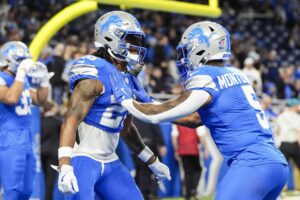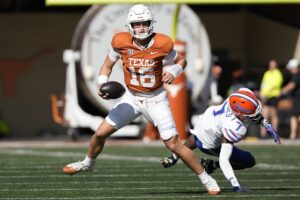For some around the NFL, it was a wonder that Isaiah Simmons fell all the way to eight in the 2020 NFL Draft. Standing at almost 6’4 and 238 pounds, Simmons is a physical specimen, possessing an athletic ability that Dabo Swinney and the Clemson Tigers utilised to full effect. The 2019 Butkus Award winner excelled at linebacker, so much so as to be declared the nation’s top collegiate player at the position, but Simmons’ athletic prowess saw him deployed at both inside and outside linebacker, as well as snaps at safety, defensive end and cornerback. Notably, Simmons played a significant number of snaps as a defensive back in Clemson’s loss to LSU in the National Championship game in January.
The Arizona Cardinals Isaiah Simmons Paradox
The decision to take Simmons to the desert was a logical one. In a rough maiden outing for the Kliff Kingsbury and Kyler Murray led Arizona Cardinals, a recurring rhetoric surrounded the team’s inability to cover the opposition tight end. This presents a significant issue, particularly when sharing a division with the San Francisco 49ers and George Kittle, widely considered to be one of the top tight ends in football. The 2019 Cardinals linebacking core boasted top pass rusher Chandler Jones and tackling machine Jordan Hicks, but unfortunately seemed to have a glaring hole when it came to pass coverage, a frailty that contributed to the team’s losing record.
Fast forward to Week Four. The Cardinals, coming off a first loss of the season to the Detroit Lions, head into a clash with the Carolina Panthers without star safety Budda Baker, who underwent surgery to repair a torn ulnar collateral ligament injury in his thumb. In a depleted group that already has other starting safety Jalen Thompson on injured reserve with an ankle injury, the conversation has emerged about the possibility of Isaiah Simmons reverting to the role that originally earned him his place at Clemson out of high school.
Assessing Isaiah Simmons to Safety
Initially, moving Simmons to safety seems to solve several problems that the Cardinals are currently facing. Firstly, it allows the team to add depth at a position that is stricken with a slew of injuries at the moment; Simmons’ range in coverage as well his history of playing safety early in his collegiate career gives the Cardinals a real option in their star draft pick.
Secondly, it allows Isaiah Simmons to garner some real NFL experience; a lack of preseason games, as well as the emergence of free agent signing DeVondre Campbell in the early part of the season, has led Defensive Coordinator Vance Joseph to limit Simmons’ snaps at inside linebacker as he continues to learn. A rough outing in Week One against the 49ers, which saw Simmons beat by Raheem Mostert on an angle route, evidenced the need for patience with the young star who, to be fair, has been deprived of a complete preparation period amid the COVID-19 pandemic.
However, Kingsbury and Joseph might seem reluctant to use Simmons as a stopgap at safety. Both have asserted since the acquisition of Simmons that he is intended to play as a linebacker, although conceding that sub-packages were being developed that allowed the Cardinals to properly utilise Simmons’ talents; Simmons has worked out with the defensive back units in Arizona, although the team sustained that this was largely to work on footwork and the maintenance and development of Simmons’ coverage skills, rather than an indication of any position change. This was reiterated by Cardinals star Patrick Peterson during media availability on Thursday, who noted that “Isaiah hasn’t been at safety all week”. The team later announced veteran Curtis Riley as the starter for Sunday’s game.
Arizona and Isaiah Simmons’ Versatility Problem
Position versatility has been a thorn in the side of Cardinals fans for a number of years. Notably, fellow linebacker and 2017 first-round draft pick Haason Reddick has seen the early part of his NFL career marred by constant position changes. Playing as a defensive end at Temple, Reddick moved to inside linebacker shortly before the Cardinals drafted him, although Reddick’s pass rush skills ultimately failed to translate to the inside. In 2018, Reddick failed to locate a role in Steve Wilk’s 4-3 scheme.
Going into the 2020 season, having had his fifth-year option declined by the Cardinals, Reddick finds himself playing a smaller role, largely due to the signing of Devon Kennard on the outside and of Simmons on the inside, but some of the blame for the slow start to Reddick’s NFL career can be reasonably placed on his inability to lock down a single position. Remaining and continuing to develop at inside linebacker is integral to Simmons’ future.
Furthermore, injury forcing a position change is a headache for Cardinals fans that remains from last season. 2019 Second-round draft pick Byron Murphy was selected to play slot corner, although the injury to Robert Alford and the suspension of Patrick Peterson saw Murphy playing, and struggling, on the outside; in 2019 Murphy allowed 63 catches on 98 targets for 598 yards and nine touchdowns. Kingsbury did confirm prior to the 2020 season that the intention was to use Murphy in the nickel, and the arrival of Dre Kirkpatrick after yet another Alford injury supplemented the team’s commitment to playing Murphy in his best position. Recognising the results of Murphy’s forced position change last year should play a significant role in the decision surround Isaiah Simmons in the upcoming weeks.
Summary
Isaiah Simmons’ versatility is a key component of why he was so highly coveted by the Cardinals and indeed why there is even a conversation about shifting the former Clemson star to safety. However, with Budda Baker slated by Kingsbury to return ‘sooner rather than later’, circumstances may not require such drastic responses. Cardinals fans eager to see the range of Isaiah Simmons’ abilities on full display should be patient and recognise that forcing a position change, be that due to necessity or otherwise, might not yield the results they expect and ultimately hinder the player’s development. Simmons’ coverage skills will become an important part of how Kingsbury and Joseph deploy him over the early part of his career, the best case scenario being a level of production out of Isaiah Simmons in a role that Cardinals fans might remember making a star out of Deone Bucannon in the desert in 2015.
In time, Isaiah Simmons will become the Cardinals ‘money linebacker’ and hopefully one of the most versatile chess pieces in the NFL. For now, developing the player’s core skills as an NFL linebacker should take precedent over needs in other position groups. It would, however, be interesting to see if, due to injuries in the secondary, the Cardinals staff do deploy Isaiah Simmons in order to play a role in the pass defence from a linebacking role. Either way, Kingsbury and his staff have a wealth of options, and some essential decisions to make as they take on Carolina.
Main Image:
Embed from Getty Images






